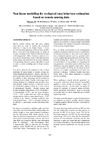Identificador persistente para citar o vincular este elemento:
https://accedacris.ulpgc.es/jspui/handle/10553/47385
| Título: | Non linear modelling for ecological tuna behaviour estimation based on remote sensing data | Autores/as: | Mangeas, M. Desruisseaux, M. Lahet, F. Ramos, A. Petit, M. |
Clasificación UNESCO: | 250616 Teledetección (Geología) 240119 Zoología marina |
Palabras clave: | Nonlinear Modelling Remote Sensing Tuna Behaviour |
Fecha de publicación: | 2005 | Conferencia: | International Congress on Modelling and Simulation: Advances and Applications for Management and Decision Making, MODSIM05 | Resumen: | Satellite remote sensing data and purse seining catch data are used to analyse the ecological behaviour of tuna in the Indian Ocean. A set of environmental parameters deduced from satellite data is extracted at the fishing points by using an interface developed at the "Institut de Recherche pour le Développement" (IRD). Statistical analysis were then carried out and some linear model and nonlinear models (neural networks) have been set and evaluated. A methodology based on genetic algorithms is used in order to avoid overfitting and to obtain suitable models. This article addresses the problem of tuna location modelling by using means of remote sensing for fishing management purposes. Indeed, tuna tend to gather in the areas where the environmental conditions are suitable for their physiology and the probability of finding foods is high. Similar work using remote sensing products for estimating tuna positions have been partially studied, but here we describe a novel and methodical approach based on a wide variety of envionmental variables. Remote sensing data include sea surface temperatures (SST), chlorophyll-a concentrations (CHL) and sea level anomalies (SLA). SST is quite used since 1976 for fishing management (at least on experimental basis). CHL is known to be related to primary production (the food pyramid base). SLA is assumed relevant as an indicator of geostrophic currents and thermocline depth. The data are structured in a database made up of two main tables: the Catch Data Table which includes the catches weight at some spatio-temporal coordinates and the Environment Table which consists of the values of environmental parameters inferred from the nearest pixels around the fishing locations. The Catch Data Table was created by Ifremer from information given by fishermen. The Environment Table is automatically filled by querying the Coverages Database. About 150000 data are referenced in the Catch Data Table. Unfortunately, due to a lack of available environment variables (some remote sensing data are very sensitive to cloud coverage), the number of useful data, may drastically drop down with respect to the diversity of model input. First, we define some features of the oceanographic conditions (within the Indian Ocean) as a combination of environmental physical data (such as the temperature), a transform operator (such as a gradient), and a relative spatiotemporal position (such as 15 days back from the fishing day). Then, we estimate the most relevant features for our problem by computing the non-parametric correlation method called Spearman (a Pearson correlation applied on data ranks). Finally, we teach a model to be fed by the determined features and to yield as output a probability of catchable tuna presence or absence. Different models have been tested, from a basic linear regression to a neural network modelling. When applying a neural network approach, we use genetic algorithms which has been successfully applied to evolve models for solving a variety of interesting problems. In this paper we apply the method to synthesis of sigma-pi neural networks. Unlike perceptron architectures, sigma-pi networks use product units as well as summation units to build higherorder terms. The neural network synaptic weights (the parameters) are obtained by using a gradient descent method (conjugate gradient) and the structure is optimized by genetic algorithms. The most promising model provides an 80% accurate rate (the model fails to predict the tuna absence or presence in 20% of the cases) versus 70% for the best linear regression and 50% for the actual fishing methodology. Our results show that the relationship between the environmental conditions and the tuna behaviour is quite non linear and that simultaneous use of both chlorophyll-a concentrations and sea level anomaly increase significantly the average accurate rate. | URI: | https://accedacris.ulpgc.es/handle/10553/47385 | ISBN: | 0975840002 | Fuente: | MODSIM 2005 - International Congress on Modelling and Simulation: Advances and Applications for Management and Decision Making, Proceedings, p. 2574-2580 |
| Colección: | Actas de congresos |
Visitas
55
actualizado el 09-dic-2023
Descargas
28
actualizado el 09-dic-2023
Google ScholarTM
Verifica
Altmetric
Comparte
Exporta metadatos
Los elementos en ULPGC accedaCRIS están protegidos por derechos de autor con todos los derechos reservados, a menos que se indique lo contrario.
